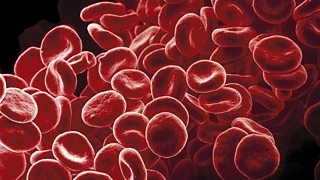How Does Energy Flow In The Cells Of An Animal After Blood Delivers Oxygen And Digested Food To Them
Cellular respiration and transport
The circulatory system transports substances between the exchange surface and cells. It delivers oxygen and glucose to the tissues for respiration, which is the release of free energy to cells.
Blood
The limerick of blood
Claret transports materials and distributes heat effectually the torso. It besides helps to protect against affliction. Claret contains plasma , which is a liquid that the other components of claret are suspended in.
Plasma is a straw-coloured liquid that makes up merely over half the book of claret.
This table explains the functions of diverse blood components.
| Component | Function(south) |
|---|---|
| Plasma | Transporting dissolved carbon dioxide, digested nutrient molecules, urea and hormones; distributing heat |
| Red claret cells | Transporting oxygen |
| White claret cells | Ingesting pathogens and producing antibodies |
| Platelets | Involved in blood clotting |
Red blood cells
Red blood cells (also called erythrocytes ) send the oxygen required for aerobic respiration in body cells.
They must be able to absorb oxygen in the lungs, laissez passer through narrow blood capillaries , and release this oxygen to respiring cells.
Reddish claret cells accept several adaptations that enable them to bear out this function:
- They comprise the poly peptide haemoglobin , which gives them their cherry colour
- \[\text{haemoglobin} + \text{oxygen} \rightleftharpoons \text{oxyhaemoglobin}\]
- Haemoglobin tin can combine reversibly with oxygen. This is important - it means that it can combine with oxygen as blood passes through the lungs, and release the oxygen when it reaches the cells.
- They take no nucleus and so they can contain more haemoglobin.
- They are small and flexible so that they tin fit through narrow blood capillaries.
- They take a biconcave shape - they are the shape of a disc that is curved inwards on both sides - to maximise their surface surface area for oxygen absorption.
- They are thin, and so there is only a brusque distance for the oxygen to diffuse to reach the centre of the cell.

White claret cells
There are several types of white blood cell.
Phagocytes
About 70 per cent of white blood cells are phagocytes . Phagocytes engulf and destroy unwanted microorganisms that enter the blood, by the process of phagocytosis .
Lymphocytes
Lymphocytes make up about 25 per cent of white blood cells. Lymphocytes produce soluble proteins called antibodies when a foreign torso such as a microorganism enters the torso.
Antibodies neutralise pathogens in a number of ways:
- they demark to pathogens and harm or destroy them
- they coat pathogens, clumping them together so that they are easily ingested by phagocytes
- they demark to the pathogens and release chemical signals to attract more phagocytes
Lymphocytes may besides release antitoxins that stick to the toxins that the microorganism makes, which stops information technology damaging the body.
Both phagocytes and lymphocytes are part of the body'due south allowed organization .

Platelets
Platelets are jail cell fragments produced by giant cells in the bone marrow .
Platelets stop bleeding in 2 chief means:
- they have proteins on their surface that enable them to stick to breaks in a claret vessel and clump together
- they secrete proteins that effect in a series of chemical reactions that make blood clot, which plugs a wound
Source: https://www.bbc.co.uk/bitesize/guides/zsw3jty/revision/1
Posted by: corsochaused.blogspot.com

0 Response to "How Does Energy Flow In The Cells Of An Animal After Blood Delivers Oxygen And Digested Food To Them"
Post a Comment